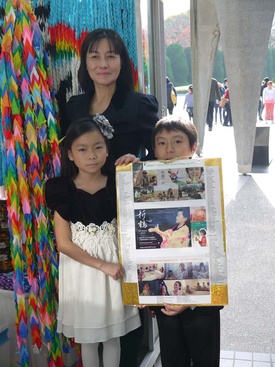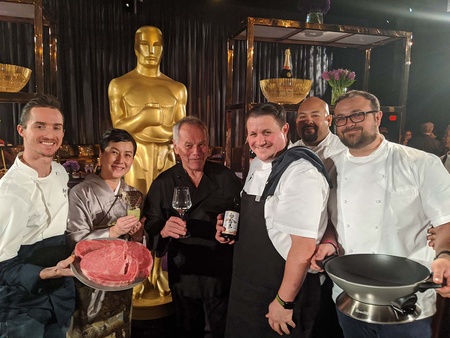Bringing our hometown Miyazaki beef to the world
Miyuki Sohara, a Los Angeles resident, is the director and producer of the films "Hannari" and "Origami Crane." "Hannari" depicts the Japanese spirit of hospitality, and "Origami Crane" introduces Japanese consideration to the world through film. She is currently working on a new film on the theme of "Return Dolls," a return gift to the blue-eyed dolls sent by America to Japan as a token of friendship.
I had interviewed Sohara when "Hannari" was completed, and since then I began to hear his name more frequently through his remarkable achievements as a "Miyazaki Beef Ambassador," who successfully introduced Miyazaki beef as a menu item at the Oscars' Governors Bowl (the party following the Academy Awards ceremony). The Oscars is certainly a film festival, so a simple question arose: why Miyazaki beef for Sohara, a director and producer? When asked about this, he replied, "It all started with the foot-and-mouth disease issue in Miyazaki. Miyazaki Prefecture, where I'm from, is a producer of Wagyu calves and breeding bulls. However, there was a time when the foot-and-mouth disease problem put the survival of Miyazaki beef in jeopardy, so I felt a strong desire to do something for the local area and for Miyazaki beef. That's when I thought of Wolfgang Puck, a friend of mine who was a fellow parent at my son's school. As you know, he is the chef in charge of the Governor's Bowl. We were on casual terms when we met at school, and he was already serving Miyazaki beef at CUT, the steakhouse he runs, so I thought there must be a possibility that he could serve Miyazaki beef for Oscar's dinners."
However, the negotiations did not go smoothly. It took nearly a year to finally reach a meeting with Wolfgang himself to discuss a concrete menu. Sohara did not give up and continued to contact him numerous times. "He already knew the taste and quality of Miyazaki beef, so in my letters I emphasized my love for my hometown. I conveyed my honest desire to contribute to my hometown of Miyazaki, even though I live in the United States. I also explained about foot-and-mouth disease and that Miyazaki Prefecture is a producer of Wagyu breeding bulls and calves.
"If we don't save Miyazaki beef, Japanese wagyu beef will die out, and I made a passionate appeal for the need to Save Miyazaki." Thanks to Sohara's persistent negotiations and the support of Chef Yahagi, who was the executive chef at Wolfgang's restaurant, the Wolfgang's side had already decided to adopt Miyazaki beef by the time the meeting finally took place. Thus, in 2018, 2019, and 2020, Miyazaki beef and Kirishima shochu delighted the palates of Hollywood celebrities at the Governors Bowl at the Oscars for three consecutive years, and in 2020, green tea from Miyazaki was also adopted.
The next theme is a thank-you doll
Sohara himself said, "As a bridge between Japan and the United States, I will continue to be involved in activities to introduce food, which is part of Japanese culture, and entertainment to the United States and the rest of the world." So how did Sohara end up in Los Angeles from his hometown of Miyakonojo City, Miyazaki Prefecture? We asked him to look back on his life.
"I moved to the US in 1999. My first husband was American, so I moved to New York where he was working. Before that, I had been a station announcer in Japan, and then worked as a freelance announcer. Looking back, I was originally devoted to ballet and my dream of becoming a musical actor was. A knee injury changed my dream to becoming an announcer, but a few years before emigrating to the US, I even studied dance for about two months. After moving to New York, I became passionate about ballroom dancing and opened a dance school."
In 2001, while Sohara was busy teaching dance and competing in competitions in New York, the terrorist attacks occurred. However, on the day of September 11th, Sohara was not in New York but in Europe. "I saw the footage of the planes crashing into the Pentagon on the news. When I saw the footage from the World Trade Center, it was so hard to accept that it was real that I thought it was a trailer for a new movie or something." After returning to New York, she volunteered by holding charity dance performances to support victims of the disaster.

After her divorce, Sohara moved to Los Angeles in 2003. "I wanted to get a fresh start. I could always go back to Japan, but I decided to stay in the U.S. to try my best, including improving my English." She met her current spouse in Los Angeles and became a mother. She then entered the film industry in the entertainment capital of the country, completing the aforementioned "Hannari." In 2015, she released "Origami Crane," a film with a message of peace based on the true story of Sadako Sasaki, a survivor of the atomic bomb who died of leukemia.
Sadako's family donated the cranes that Sadako had folded while she was in her hospital bed to the Museum of Tolerance in Beverly Hills and the Japanese American National Museum in Los Angeles as a "symbol of peace." Sohara was the go-between and sponsor of this donation.
The title of his third film is "Friendship En Dolls." In 1927, Dr. Gulick, an American missionary concerned about the conflict between Japan and the United States, called on people across the United States to collect 13,000 dolls and send them to Japanese children. In return, the Japan International Children's Friendship Association, led by Eiichi Shibusawa, called on people across Japan to donate 58 Ichimatsu dolls to the United States. Sohara's next work will be a new work based on the motif of this exchange between Japan and the United States from nearly a century ago. "The donation of the dolls was a project that started to relieve racial discrimination against Japanese immigrants to California, so I got excited thinking about passing it on to future generations," he said. He will start fundraising in the future and aims to release the film in 2024, when Eiichi Shibusawa will appear on the 10,000 yen bill in Japan.
Finally, we asked Ms. Sohara, mother of two children, ages 16 and 13, what she hopes for her second-generation Japanese-American children. "I want them to cherish their pride as Japanese, so I've taken them to Japan, the land of my roots, many times since they were young so that they could experience the real Japan. But now that we live in a global age, I don't want to categorize them by race." The image of their mother working hard as a bridge between Japan and the United States must be burned into the minds of her children.
Official site: www.sakuraproduction.com
© 2020 Keiko Fukuda






